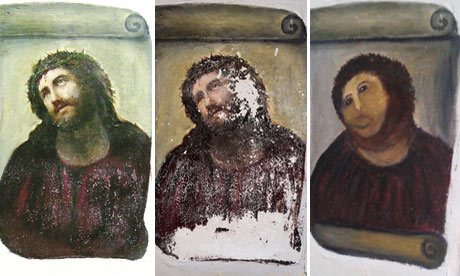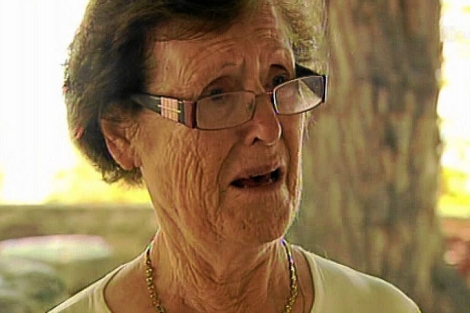
Ecce Homo by Elías García Martínez showing damage caused by an elderly woman who decided to restore the masterpiece
西班牙著名“壁畫城”波爾喆是個宗教、藝術名城。一位“好心”的老奶奶在本地教堂對一幅“耶穌受難前”的壁畫做了大膽的修補!
在今天的網絡世界裏,這個大膽的行為使得老奶奶出名了,而且媒體和公眾的指責讓老奶奶吃不消了。
如果這幅畫是在老奶奶自家的廚房或庭院內,是她自己祖上留下來的,那麽,這種糟蹋可能不會引起如此的震驚。可是,這種文化遺產(甚至是世界文化遺產)就這麽被毀了容,導致地方神父欲起訴老奶奶的想法。

“我係愛耶穌滴啊!”
畫畫兒是個浪漫、消遣的藝術創作和陶冶情操的事兒;小孩子、老人畫畫更是一種有益身心的活動。你在你自己的本子上、家裏畫,畫什麽也沒人管,是件自由自在的事情。可你不能隨便碰別人的東西啊!!
試想,如果一個“好心”的中國人拿著榔頭、鑿子去“修補”碑林,或一位業餘老書法家擅自“彌補”一位古人書法真跡,中國人的“反響”可能就不止這些了!
人類對藝術真跡的欣賞和珍惜是人類文化、文明的“文化基因”和“審美”進化。贗品是天才騙子的傑作!
文化藝術裏的真、善、美是非常明顯的,盡管我們有時看不見“成文的”標準。藝術中的“神來之筆”和現實裏的“神經病之筆”是兩碼子事,所以,人類有了學院、法院、博物館、文化保護等等。
“真跡”也超越了“藝術”的範疇。我們祖先、祖宗傳下來的東西,包括物品、影像和衣物等的價值不是用“藝術”來衡量的,而是真實的情感價值。這種“真”對他人來說可能毫無“價值”,但我們知道它們的珍貴。
不論是老人還是孩子,當他她們煩了錯誤,我們基於常識很容易原諒他們,因為他她們的大腦老化或不成熟,與“年齡歧視”無關。
俗話說,沒有那金剛鑽兒,就別攬那瓷器活兒!
老奶奶的神智影響了她對自己“繪畫技能”的客觀判別和對文化遺產的正確理解。但老奶奶又不是在“老人院”裏的那些“藝術家”!現實裏,老人院和精神病院裏照樣有很多老人畫出可愛的、震撼的畫兒來。
事實是,每個人都具備主觀能動性和“自由”,當他她們不被約束時,可能會做出損害他人或自我的事情,甚至是對自我有害的思維。這可能就是人們常常將思維不靈敏的老人稱為“老小孩兒”的原因,他她們和小孩子一樣需要成年人的照顧和保護。
神智清醒的、正常的成年人在故意做蠢事和胡言亂語時,後果都會找上門兒來。可能有人會以為虐待自己的大腦和價值觀和他人沒關係,但這和老年人、小孩兒的錯誤行為是有著本質的區別的。
這位老奶奶聲稱不是故意去給耶穌毀容,甚至是光明正大地去修補壁畫,當地教會也說要起訴她。可是,除了尋求專業的補救、複原,他們對於老奶奶(老小孩兒)又能怎樣呢?
L
衛報:
An 81-year-old who garnered worldwide media attention after she tried – and spectacularly failed – to restore a painting in her local church may face legal charges.
Cecilia Giménez, the well-intentioned amateur restorer from the Spanish city of Borja, is reportedly in bed after an anxiety attack, with neighbours and relatives suggesting she feels overwhelmed because of the media frenzy over the unintentional damage she caused to the mural.
The damage to the painting in the church of la Misericordia de Borja is reportedly being investigated by experts, with the artist's descendants apparently unhappy that an individual decided to take the restoration job into her own hands. They fear her handiwork may be irreversible.
Giménez told Spanish television that the priest knew about her attempts at restoration to the Ecce Homo painting by Elías García Martínez and that she had done nothing in secret. "The priest knew it and everyone who came into the church could see I was painting," she said.
Although no one seems sure when she embarked on the restoration project, news of the incident first appeared on the blog of the Centre for Borja Studies a fortnight ago.
The centre posted some before-and-after pictures, along with a plaintive message confirming that someone had recently been up to no good with a brush.
"As incredible as it may seem, this is all that remains of the work of an artist whose descendants still live in our city," it said. "We do not know whether this unspeakable deed can de remedied, but there can be no doubt whatsoever that someone should take the necessary action to ensure that such behaviour is not repeated. Whatever the motives were, it must be roundly condemned."
Professional restorers plan to examine the painting to gauge whether restoration is possible.
According to the local paper El Heraldo de Aragón, the city council is reportedly considering legal action against Giménez. Her actions meant the 19th-century painting, which was already in a poor condition, had been "completely destroyed", one councillor, Juan María de Ojeda, said.
Ojeda nonetheless criticised media attention as "disproportionate".
Giménez's efforts have been variously been dubbed "the worst restoration in history", "a botched job", and "a crayon sketch of a very hairy monkey in an ill-fitting tunic".
請閱讀更多我的博客文章>>>